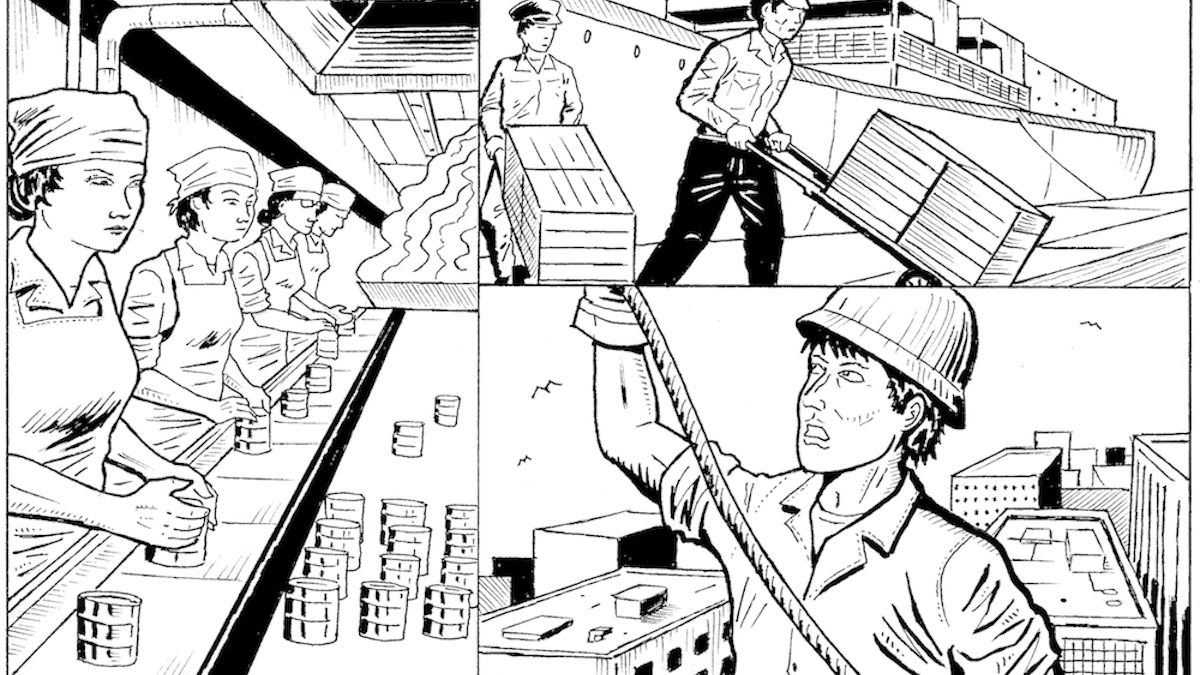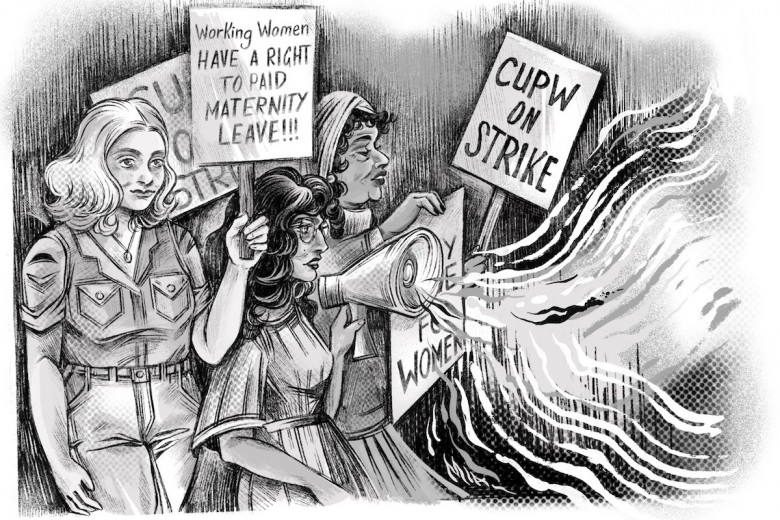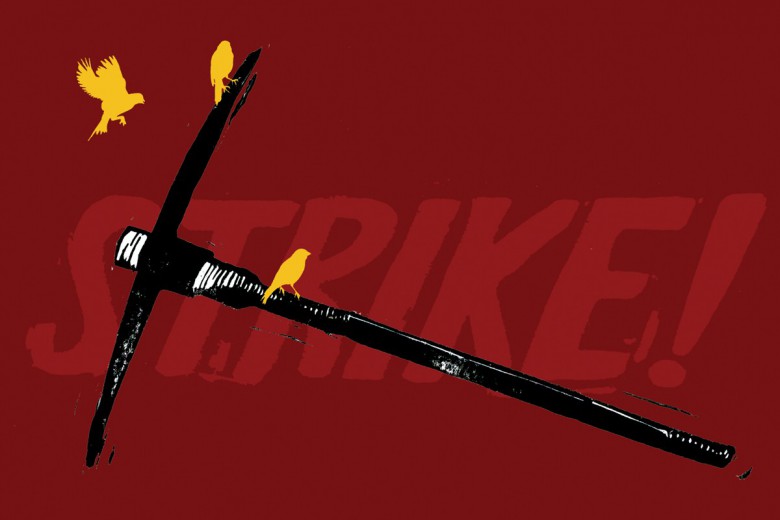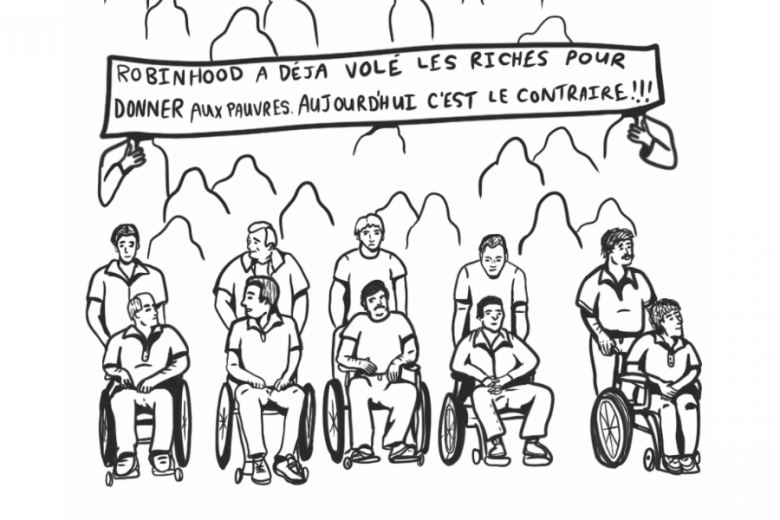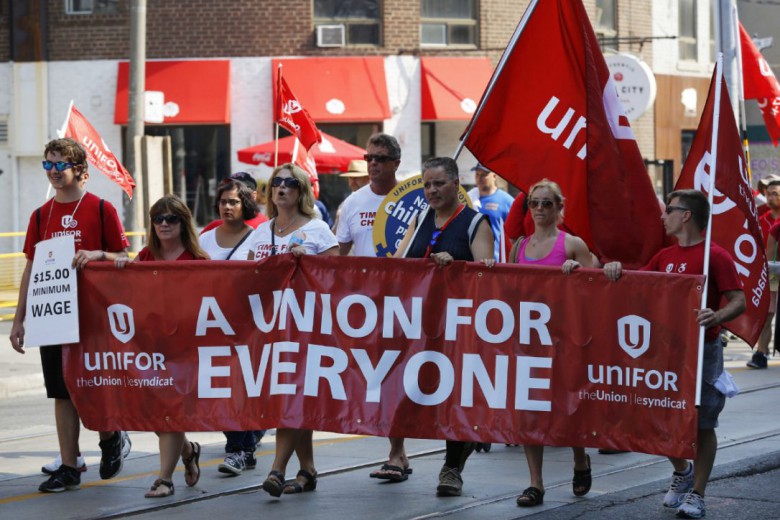Indigenous people have always been active in labour struggles, both as part of the wider labour movement and as members of their own communities.
Prior to invasion, Native labour had already been integrated into the land itself through the management of fires, water, and food resources. This work added use-value and potential productivity to the land and natural resources – Indigenous people built irrigation systems and planted crops that nourished the soil, and they set fires to help clear brush and renew growth. Colonizers would later exploit this work for the benefit of their own businesses and governments.
Once Native people took up wage work for non-Native employers, their work was significant in building the infrastructure of Canada and the U.S. – and they fought against exploitation and racism on the job. This article presents a partial chronology of some important moments in Indigenous labour history.
Strikes, organizing, and workers’ struggle
In an interview about the urban Métis community Rooster Town, which existed within the greater Winnipeg area in the first half of the 20th century, Warren Mills, who grew up nearby, explains that several area businesses “ran on Métis labour.”
In 1893, thousands of Native fishery and cannery workers in the greater Vancouver area took part in one of British Columbia’s first major strikes, in a wage and price-per-fish dispute aggravated by discriminatory distribution of licences. This was followed by a series of strikes by Indigenous fishery workers to the north, on the Skeena and Nass Rivers, in 1896, 1897, and 1904.
Native longshore workers in Vancouver (Sḵwx̱wú7mesh, səlilwətaɬ, and xʷməθkʷəy̓əm territories) in 1906 organized their own local branch of the Industrial Workers of the World (IWW) and then a branch of the International Longshoremen’s Association in 1913.
Money earned through longshore work helped pay for a trip in 1906 by three Salish chiefs and an interpreter – Chief Joe qiyəplenəxʷ/Capilano, Chief Charley Isipaymilt, Chief Basil David, and Simon Pierre – to England to present a land rights petition directly to the King. The petition was rejected, but it showed that labour and land rights struggles are not necessarily separate.
This history of Indigenous labour in Vancouver was also depicted by Secwepemc artist Tania Willard in her chapter of the 2016 comic book anthology, Drawn to Change: Graphic Histories of Working-Class Struggle.
Native workers – their lives and their labour – were subject to far greater control by the State and individual settlers.
Indigenous labour played a significant role in the construction of bridges, railways, and skyscrapers. In 1907, 33 Kanien’kehá:ka ironworkers from Kahnawà:ke died in the collapse of the Quebec Bridge near Quebec City. The women of the community subsequently insisted that work groups spread out between construction projects to prevent so much loss of life from a single accident in the future. This policy was initially followed, as a construction boom in both Canada and the United States also multiplied the amount of potential work sites.
In the 1940s, the Department of Indian Affairs placed some Indian residential school students as domestic workers in the homes of government officials in the Ottawa area and at the Ottawa General Hospital. This was followed by a similar program in Calgary in the 1960s.
These examples highlight one difference between Native and non-Native labour during this time period: Native workers – their lives and their labour – were subject to far greater control by the state and individual settlers. This point is detailed by Lenape historian Mary Jane Logan McCallum in her 2014 book, Indigenous Women, Work, and History.
Stó:lō/Métis writer and organizer Lee Maracle, in the 1990 second edition of her book Bobbi Lee: Indian Rebel, explains that Indian residential schools had children tending “orchards and farms for the priesthood instead of preparing them for the academic world like other children in this country.” Aside from residential schools, as Maracle further detailed, Indigenous people also had to work on farms and ranches in order for their families to survive, along with having to do unpaid domestic labour and organizing work.
One of the organization’s initially-stated objectives was “To generally encourage and facilitate Indian control of Indian health involvement and decision-making in Indian health care.
In 1957 and 1969, two Kanien’kehá:ka ironworkers from Akwesasne, Francis Johnson (Standing Arrow) and Richard Oakes, led high-profile land reclamations at Schoharie Creek in upstate New York and at Alcatraz Island in the San Francisco Bay Area, respectively.
In 1975, members of the American Indian Movement (AIM) took part in the occupation of the Fairchild Semiconductor plant in Diné (Navajo) territory in Shiprock, New Mexico. They were protesting against ill treatment by managers and workers – largely women – being paid below minimum wage. Unfortunately, the company’s response was to shut down the plant and move it overseas, leaving behind hard feelings toward AIM.
Also in 1975, Indigenous nurses gathered at a conference in Montreal and organized themselves as the Registered Nurses, Indian and Inuit Association of Canada, now the Canadian Indigenous Nurses Association (CINA), to promote better health for Indigenous people and to better position and represent Indigenous people in health care work. One of the organization’s initially stated objectives was “To generally encourage and facilitate Indian control of Indian health involvement and decision-making in Indian health care.” Longtime nehiyaw organizer and writer Jean Cuthand Goodwill was one of the founders of the association.
Native court workers in the province had been paid $10,000 less a year than their non-Native counterparts.
Native workers at the Muckamuck Restaurant in Vancouver in 1978 organized themselves as part of the Service, Office and Retail Workers’ Union of Canada (SORWUC) and went on strike against low wages, illegal fines, and racist comments from management. Management used various tactics against the union, including strike breakers, until finally closing the restaurant and moving their assets back to the United States.
Later, in 1983, the Labour Relations Board of British Columbia ruled that management owed the union $10,000 in compensation, but the union was never able to actually recover the money because the employer had fled the country. Despite this, some Indigenous strikers still spoke of their action and their engagement with the union movement as a positive experience in terms of learning and self-empowerment.
In 2014, Native court workers with the British Columbia Government and Service Employees’ Union (BCGEU) went on strike for wage parity and won. Prior to the strike, Native court workers in the province had been paid $10,000 less a year than their non-Native counterparts.
Native labour today
Both currently and historically, some local branches of major unions have had a primarily Native membership. Unions such as the United Food and Commercial Workers (UFCW) and the Hospital Employees’ Union (HEU) also have Indigenous-specific committees for and by their membership.
Recently, Local 1006A of the UFCW and Local 1857 of the International Association of Machinists and Aerospace Workers (IAMAW) won arbitration cases that force employers to recognize the new National Day for Truth and Reconciliation (held on the same day as Orange Shirt Day) as a statutory holiday for their members under existing collective agreements.
Aside from these cases, the National Day for Truth and Reconciliation so far has only been officially recognized as a holiday for federal employees of the colonial government, while most other workers, including Indigenous workers, have been forced to continue to provide services to the government officials who now have extra shopping time.
The struggle continues “to push our unions in a new direction: closer to the grassroots struggles from which we have been distant for so long.”
In June, the Public Service Alliance of Canada (PSAC), which has some 230,000 members, relaunched their public campaign for clean drinking water for First Nations communities, in collaboration with communities such as Grassy Narrows and Samson Cree Nation, accompanied by supporting testimony from Indigenous PSAC members on the campaign’s website.
However, PSAC as a union also includes prison guards, border guards, and RCMP civilian employees, despite prisons, borders, and police being among the most oppressive and colonial of institutions faced by Indigenous peoples and despite increasing criticism of the inclusion of prison guards and police in unions.
Aside from the wider union movement, Native communities have also had to continue to fight just to be able to manage and work their own resources. Sipekne’katik First Nation members on the East Coast, for example, in 2020 faced racist attacks from white fishers simply for engaging in a self-directed treaty lobster fishery program.
In contrast, during the recent struggle for Land Back Lane at Six Nations of the Grand River, non-Native members of several unions, the Hamilton and District Labour Council, and the Ontario Federation of Labour showed up to support the Haudenosaunee struggle to stop unsanctioned development on their land.
“Instead of the people competing with each other, they shall help and co-operate with each other.”
This support may have been influenced by pre-existing connections or a sense of labour solidarity, given that Haudenosaunee and specifically Kanien’kehá:ka citizens have been renowned for more than a century as ironworkers and as members of ironworker unions, as depicted in Abenaki filmmaker Alanis Obomsawin’s 1997 documentary film Spudwrench – Kahnawake Man.
Today, the struggle continues “to push our unions in a new direction: closer to the grassroots struggles from which we have been distant for so long,” as otipêmsiw organizer Molly Swain and organizer Amber Gross put it in their analysis of the Quebec student strikes in 2012 and 2015 and the wider labour movement’s relation to them.
One of these grassroots struggles is the Indigenous movement to reclaim land and resources, while opposing the capitalist system of exploitation for private gain.
As Kanien’kehá:ka writer and artist Karoniaktajeh (Louis Hall) wrote in his 1974 Ganienkeh Manifesto, “Instead of the people competing with each other, they shall help and co-operate with each other.”


